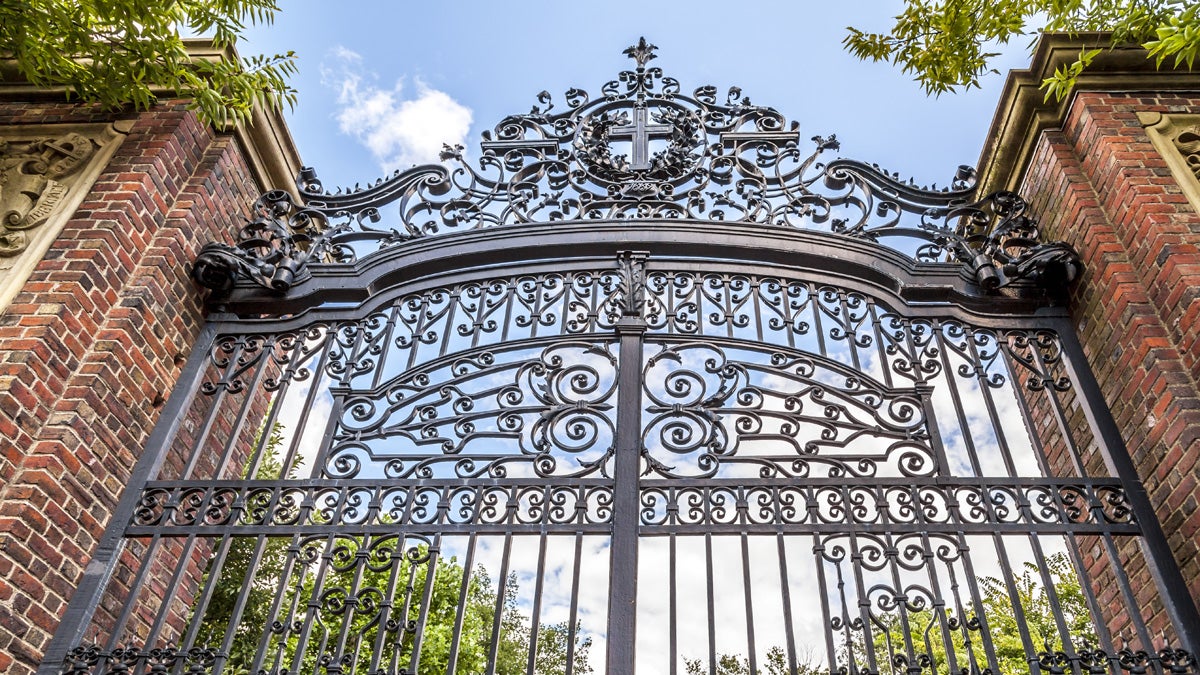It’s never too late to go back to school for a day

(Harvard University iron gate image courtesy of Shutterstock.com)
Question: Why would a middle-aged couple with 12 years of higher education between them give up a brilliant fall Sunday to go to school?
Answer: One Day University, a program that’s kept us thinking long after the last bell.
The format is both simple and brilliant, gathering the most accomplished, popular faculty members from the country’s leading colleges and universities to convene for a day in Philadelphia to give lively one-hour lectures. These professors, the ones whose classes always have waiting lists, from Harvard to Haverford, represent the latest thinking on such pertinent issues as politics, healthcare, and psychology.
The idea of being lifelong learners (sans student loans) appealed to me and my husband. We like getting up to speed on timely topics. And we like filling in the gaps of our own knowledge.
When I was in college, I majored in French and Spanish, with a few Italian courses thrown in. Though I became fairly proficient in foreign languages, I had little time for government or history — important disciplines that my future husband (then my classmate) studied in depth. As an adult, I realized how little I knew about the evolution of America’s founding documents, about economics, or art, or philosophy.
So, on a recent Sunday, my husband and I joined 1,100 other eager students at the Philadelphia Marriott to go back to college for a day. I chose five classes from the 13 offered. They were all terrific, and they all plugged a few holes in my education:
“How to look at and understand modern art,” by Georgetown University professor Ori Soltes
“Ethical dilemmas and modern medicine: Questions nobody wants to ask,” by Jacob Appel, a psychiatrist and lawyer who has taught at NYU, Columbia and Brown
“1968: The extraordinary events of a memorable year,” by American University professor Leonard Steinhorn
“German resistance in WWII: What we know now that we didn’t know then,” by international media expert and former Columbia University faculty member, Anne Nelson
“How Americans think about punishment, revenge, anger and forgiveness,” by Amherst College professor Austin Sarat
The lectures were as thought-provoking as any that I once attended at college — and, because no one was recovering from a night of youthful revelry, occasionally more lively. Our “classmates” looked like adult versions of the top students we might have seen at college a generation or two ago.
So, what did I learn?
I have always wanted to study art in a formal way, and Ori Soltes’ lecture was a great start. As he traced the history of art, starting from the time of ancient Egyptians, I learned how each period of art has been considered “modern” by the people of its time, building on the style that preceded it. For example, the Pop Art of Andy Warhol, epitomized by his depiction of ordinary Campbell Soup cans, was a reaction to a past when art reflected religion and politics. Instead, Warhol made art a commodity — one that may even have influenced a consumer purchase or two.
Anne Nelson’s lecture on German resistance to World War II was particularly enlightening. Dr. Nelson explained that the 1989 fall of the Berlin Wall gave Westerners unprecedented access to a wealth of unknown documents. These documents reveal how everyday Germans put up a determined if clandestine resistance to the Nazi war machine. These Germans were Catholics, Lutherans and Mormons, as well as Jews; they were military officers as well as students, artists and politicians. Many lost their lives. Nearly 5,000 Germans alone were executed for an attempted coup against the Nazi dictatorship in July 1944. Many others would be executed by hanging and the guillotine.
My husband took two courses with me, and three others on his own. So when we met for lunch at the Reading Terminal, we had plenty to talk about. My better half particularly enjoyed “The Paradox of Choice: When More is Less,” by Swarthmore College’s own Barry Schwartz. He explored how an abundance of choice can actually lead to dissatisfaction — a phenomenon well known in our increasingly materialistic society.
I came home with a mental list of more things I wanted to learn, more books I wanted to read. One Day University was a great way to clean out my mental cobwebs and meet inquiring minds. There was plenty to learn — and, best of all, no homework!
WHYY is your source for fact-based, in-depth journalism and information. As a nonprofit organization, we rely on financial support from readers like you. Please give today.

